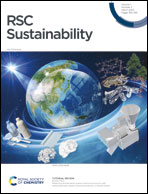Highly efficient lithium-ion battery cathode material recycling using deep eutectic solvent based nanofluids†
Abstract
Waste battery materials are precious resources that can be recycled under certain specific conditions. Traditional recycling methods require high energy consumption, have low efficiency, and lead to serious pollution. With the aim of developing a mild and efficient approach to recycle spent cathode materials of lithium-ion batteries (LIBs), nanoparticles dispersed in deep eutectic solvents (DESs), herein referred to as nanofluids, for the first time, were utilized as a medium for recycling LIBs. 100% liberation efficiency was achieved under mild conditions thanks to the collaboration of DESs and nanoadditives, in which DESs worked as a medium for dispersing of cathode materials and nanoadditives enable an enhancement of heat and mass transfer of the solvent system. Notably, though the main aim of this work is the liberation of the cathode active material from spent LIBs, it is shown that the presence of nano-additives in DESs could double the metal leaching efficiency in comparison to that of pure DESs. A mechanistic study of static thermal properties and dynamic observation of nanofluids demonstrated that the liberation rate could be enhanced by 15% with a 0.8% thermal conductivity (k) enhancement when boron nitride (BN) was employed as a nanoadditive. Additionally, simulation of the recycling process via a computational fluid dynamics (CFD) method indicated that mass transfer plays a key role in enhancing the recycling rate of LIB materials. Moreover, DESs could be used at least five times without affecting their recycling activity. In view of the low energy consumption, low toxicity, recyclability, and simplicity of the experimental procedure described herein, it offers a promising approach for the recycling of LIB cathode materials at an industrial scale.



 Please wait while we load your content...
Please wait while we load your content...